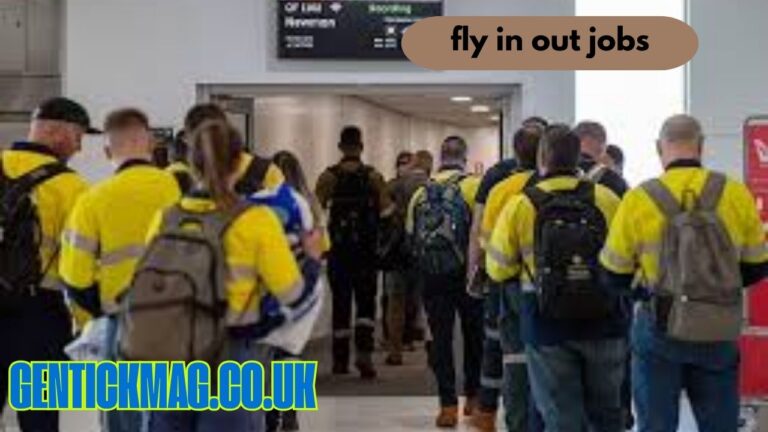Introduction
In recent years, the term fly in out jobs has become a popular topic among job seekers looking for unique work arrangements. These positions, often found in industries like mining, oil and gas, construction, and remote infrastructure projects, offer the chance to work in distant locations while traveling back home during off-shift periods. This work model is attractive for those seeking high pay, adventure, and a structured schedule that allows extended time off. In this guide, we’ll explore everything you need to know about fly in out jobs, including industries, benefits, challenges, and how to secure one.
What Are Fly In Out Jobs?

Fly in out jobs, sometimes referred to as FIFO jobs, are roles where employees are flown to a worksite — often in a remote area — for a set roster period. Once their shift block is complete, they are flown back to their home city. This setup is common in industries that operate in isolated regions without local labor pools.
Key Industries Offering Fly In Out Jobs
The most common sectors providing fly in out jobs include:
- Mining and Resources – Gold, coal, and iron ore mining sites often rely on FIFO workers.
- Oil and Gas – Offshore rigs and remote drilling operations frequently use fly in fly out rosters.
- Construction – Large-scale projects in rural or hard-to-reach areas.
- Infrastructure Development – Dams, pipelines, and major road projects in remote regions.
- Emergency and Relief Services – Short-term contracts in isolated disaster or aid zones.
Benefits of Fly In Out Jobs
Working in fly in out jobs can bring unique perks:
- High Salary Packages – Compensation is often higher to offset the demands of remote work.
- Extended Time Off – Workers might have two to four weeks off after each work rotation.
- Travel Opportunities – See regions of the country (or world) you might not otherwise visit.
- Career Advancement – Access to specialized roles in growing industries.
- Accommodation and Meals Included – Many employers provide free housing and food during shifts.
Challenges of Fly In Out Jobs
Despite the benefits, fly in out jobs can be demanding:
- Isolation – Remote sites can feel lonely, especially during long rosters.
- Physical Demands – Many FIFO roles require long hours and physically intensive work.
- Family Separation – Being away from home for weeks at a time can be challenging.
- Mental Health Concerns – Stress, fatigue, and homesickness are common.
Common Roster Patterns
Fly in out jobs operate on set rosters, such as:
- 2/1 – Two weeks on-site, one week off.
- 3/1 – Three weeks on-site, one week off.
- 4/2 – Four weeks on-site, two weeks off.
Some international contracts may have longer rotations, especially for overseas projects.
Skills and Qualifications Needed
Employers hiring for fly in out jobs look for:
- Industry-specific certifications (e.g., mining tickets, safety training, offshore survival).
- Physical fitness and endurance.
- Adaptability to remote living conditions.
- Good communication and teamwork skills.
- Mental resilience.
How to Find Fly In Out Jobs
To land fly in out jobs, job seekers can:
- Search on specialized job boards for mining, oil and gas, and construction.
- Network with current FIFO workers on LinkedIn.
- Work with recruitment agencies specializing in remote work.
- Attend industry job fairs.
- Apply directly to companies operating in remote areas.
Living Conditions on Site
Accommodation for fly in out jobs typically includes:
- Camp-style housing with single rooms.
- Shared recreation areas and gyms.
- Cafeterias providing meals three times daily.
- Internet access (although sometimes limited).
- Laundry and cleaning services.
Health and Safety in FIFO Work
Because fly in out jobs are often in challenging environments, employers prioritize safety with:
- Strict adherence to occupational health standards.
- On-site medical teams.
- Regular safety drills.
- Mental health support services.
The Financial Appeal of Fly In Out Jobs
One reason many pursue fly in out jobs is the earning potential. With base salaries supplemented by overtime pay and site allowances, many FIFO workers can save significantly due to reduced living expenses during their roster periods.
Work-Life Balance Considerations
While fly in out jobs offer extended time off, balancing family life and personal relationships can be challenging. Workers often use their downtime to recharge, travel, or spend quality time with loved ones.
International Fly In Out Jobs
Some fly in out jobs are not limited to domestic locations. Skilled workers may secure contracts in:
- Remote regions of Africa for mining projects.
- Offshore oil rigs in the North Sea.
- Arctic exploration and construction sites.
These positions often include international flights and higher allowances.
The Role of Technology in FIFO Work
Modern fly in out jobs benefit from improved technology:
- Video calls help workers stay in touch with family.
- Remote monitoring tools make work more efficient.
- Digital safety systems enhance workplace security.
Career Progression
Starting in fly in out jobs can lead to promotions into supervisory or management positions. Many employers invest in training programs for long-term employees.
Tips for Success in Fly In Out Jobs

- Maintain good physical health before and during rotations.
- Stay connected with family and friends to avoid isolation.
- Take advantage of on-site recreational activities.
- Save money strategically during your contract.
Future of Fly In Out Jobs
As industries expand into even more remote regions, the demand for fly in out jobs is expected to remain strong. Renewable energy projects and infrastructure upgrades may create new opportunities in the coming decade.
Conclusion
Fly in out jobs offer a distinctive career path combining adventure, high pay, and structured time off. While they come with challenges, they remain an attractive option for skilled workers willing to adapt to remote environments. With the right preparation and mindset, a FIFO career can be both financially rewarding and personally fulfilling.
Also Read: Top 10 Best Tools for Text to Video Converters in 2025
